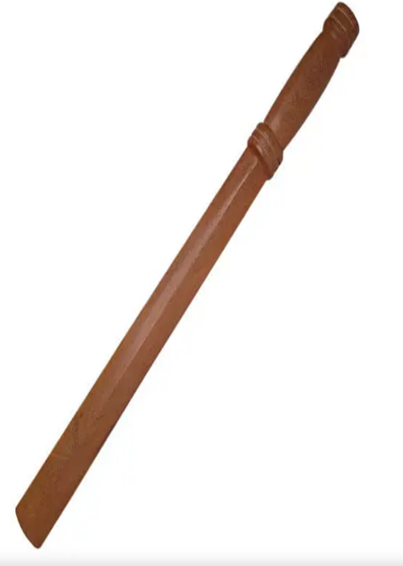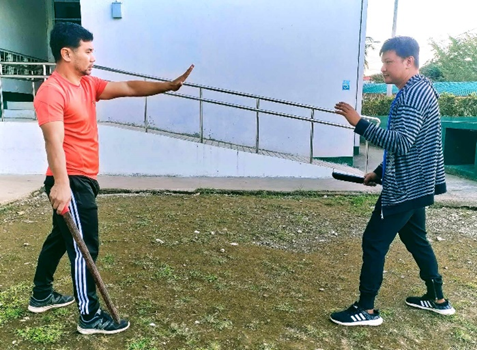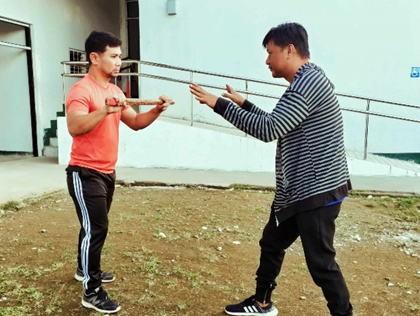Balila: Weapon of self-defense (English Version)
Balila
I'm excitedly waiting for the 'balila' I requested, it
will come from the Mindoro province. I thought of doing a blog on this topic.
The Balila refers to a flat wooden weapon in some parts of Ilocandia,
also called the brokil, a weapon for self-defense, it has a length of 30
inches, a width of 1.5 inches, and a thickness of half an inch. It is wide and
has a design on the handle, like a wooden sword, only that there is usually no
point at the end of it.
The balila is usually made from hard wood such as mahogany, bahi, or gijo. I first saw it when I was a kid around the early 70s, from the typical Batanguenos hawking and selling mosquito nets and blankets. Their product is wrapped in a common white blanket, the products are folded properly, and they carry it on their shoulders with the help of a wooden handle, this is brokil or balila. Apart from its use in carrying products, it is also definitely used to defend against possible robbers.
Balila
I heard this word from a friend, in the 90s, after I conducted a 'training the trainors' to my fellow PE teachers on how to teach arnis to our students at the Philippine Science and Technology Center. One of my companions brought it, and I was glad because I knew this tool was part of the history of arnis. I heard from him that he called it 'balila.'
A 3-generation-old Balila from a family in Batangas
Use of Balila
I decided to make a blog of what I remembered from what he shared with me because I might forget. I demonstrated it to a Fil-Am friend, but he didn't seem interested because there were no flashy moves, no drills, and no twirling. The moves are typical of how they would be used against anyone who would attack them. But for me, this is a piece of historical information about how it is used.
Striking
Haklis
The balila can be used immediately
from the rear attachment, and it is struck in an “x” manner, from the upper
right down diagonally to the left, and again struck from the upper left down
diagonally to the right.
Another way to hit from behind is to go down from the right diagonally down to the left and can be hit again from the lower left and diagonally up to the right.
Pagsaboy
This is the method of hitting with
the balila in its typical carry held from the right. It will be struck
diagonally upwards as if scattering a grain of rice. It can be struck back from
the top left down diagonally to the right side.
Paghawi
The balila is hit horizontally or
horizontally from right to left or from left to right.
Dos Manos
This is a way of holding the balila
at both ends. This can be used to block and be followed immediately by butting
or stabbing the attacker's body.
Safety
The use of the balila has two ways of
hitting the attacker. The beating with the flat width of the balila is to hurt
only and to control a person who needs to be arrested or prevented from
attacking.
The edge part for bone breaking, he flat with for slapping
The striking with the edge part of the balila is more to restrain or disarm a person by hitting the bony parts of the body such as the hand, forearm, knee, shin, and shoulder. The most avoided is hitting the head because it is fatal.
Epilogue
This is how simple he
shared with me, no complicated drills, one-on-one techniques, and stories.
Which I think is enough to be used in self-defense and take responsibility in
terms of dealing with crime in the community.
This story may also have inspired the
comic novel titled “Kamagong.” The original comic novel by Carlo J. Caparas in
the 70s is not similar to the movie “Kamagong” starring Lito Lapid. The balila
is the weapon used here, which is called 'kamagong' because the arnis (balila)
is made of mahogany wood, kamagong.
Comics pages on the novel 'Kamagong'
Such knowledge and what has been shared by people who have had experience regarding the use of weapons of self-protection is an important piece of the historical puzzle of how we can see the image of Filipino martial arts in the past decades.
Joel
D. Anajao
12/22/2024
4:30
A.M
Indang,
Cavite
Sources:
Pages of Filipino Komiks (n.d.) Aquatica, Pages of Filipino Komiks. Facebook Page, https://www.facebook.com/groups/284311875069134/posts/2081639772002993/
Acknowledgment: For Allan C. Guanlao and Wendel B. Marzo for the photos
To Noel Lopez who showed the 3-generation-old balila as part of their family heirlooms
















Comments
Post a Comment